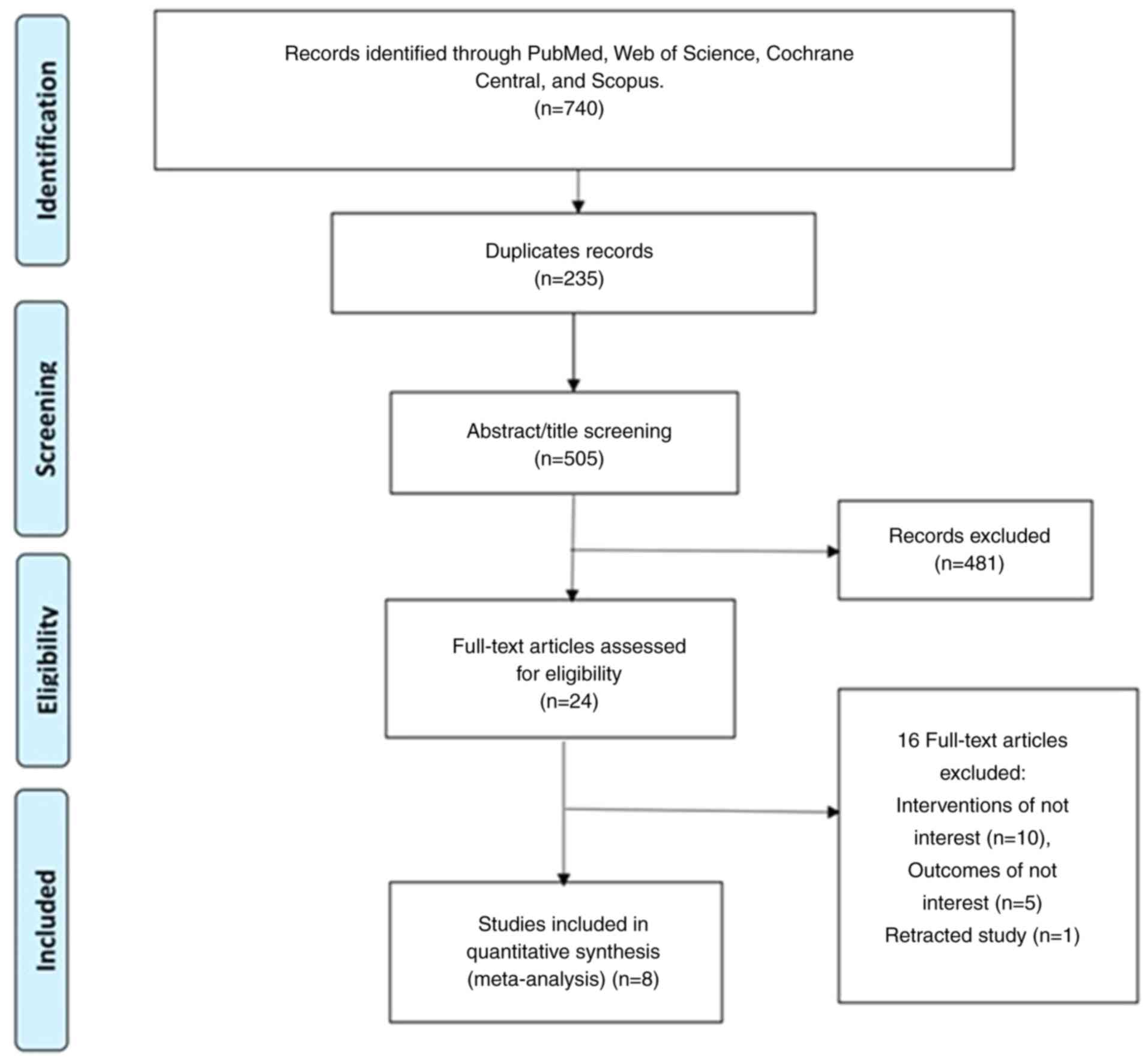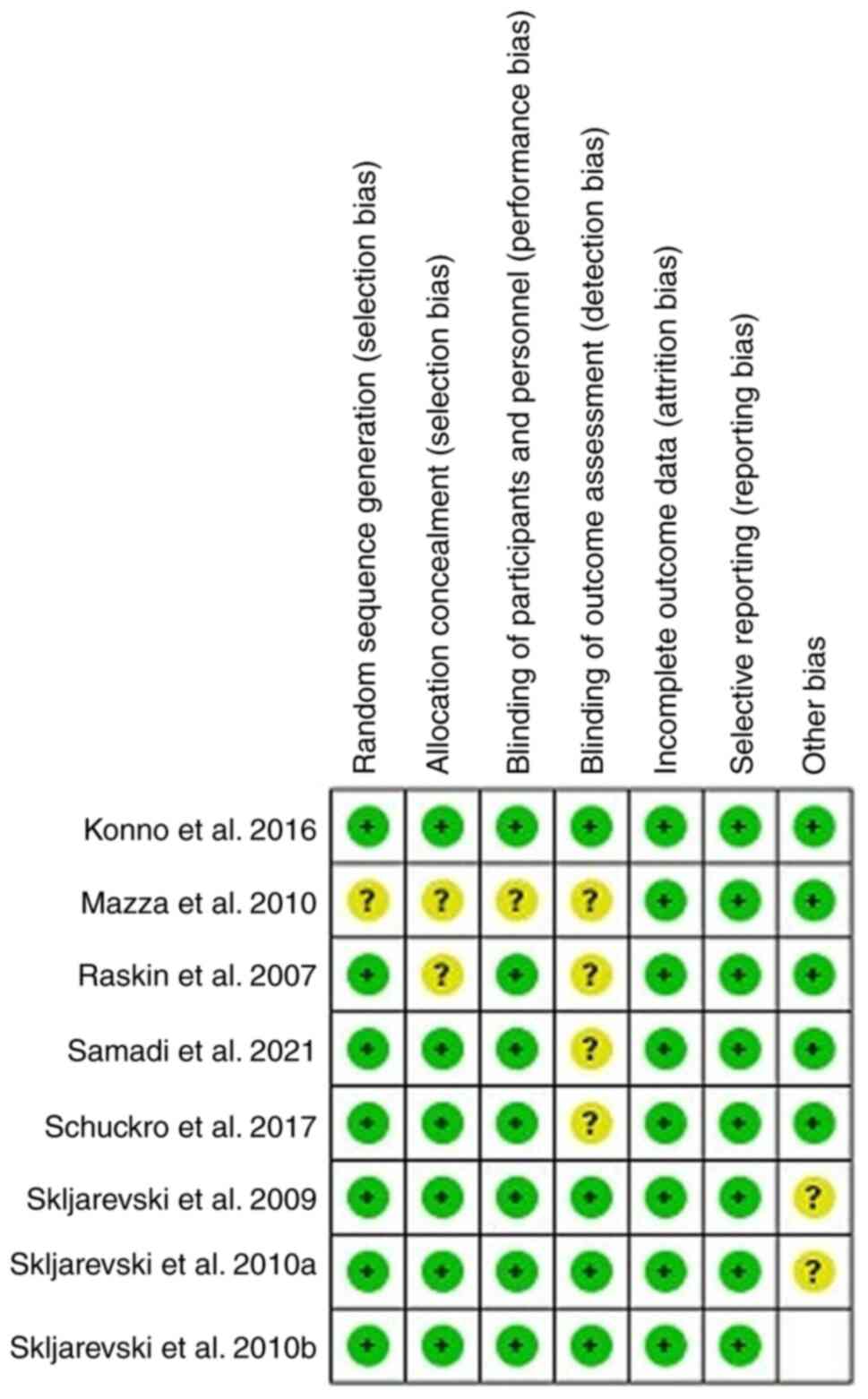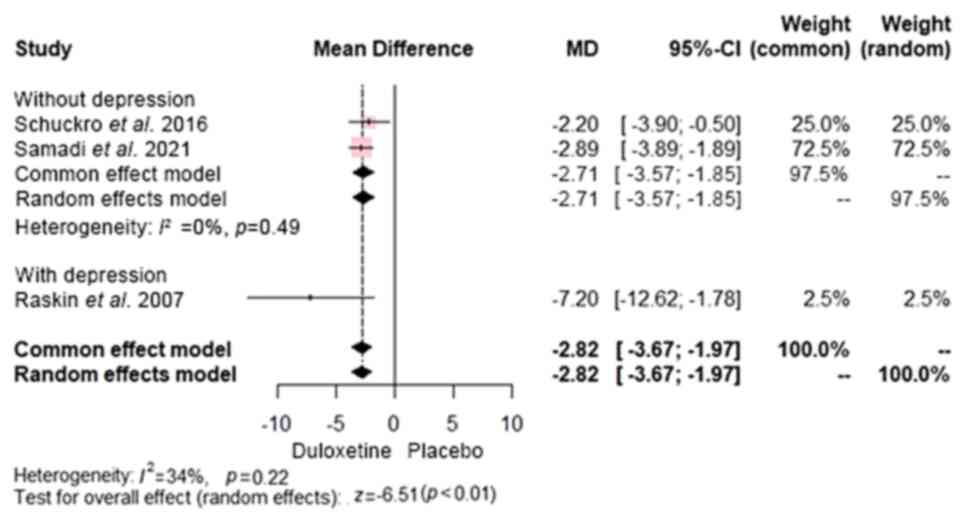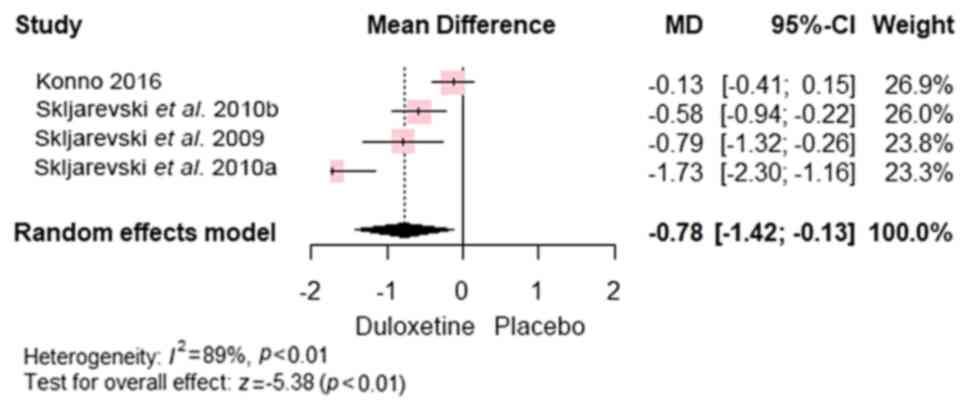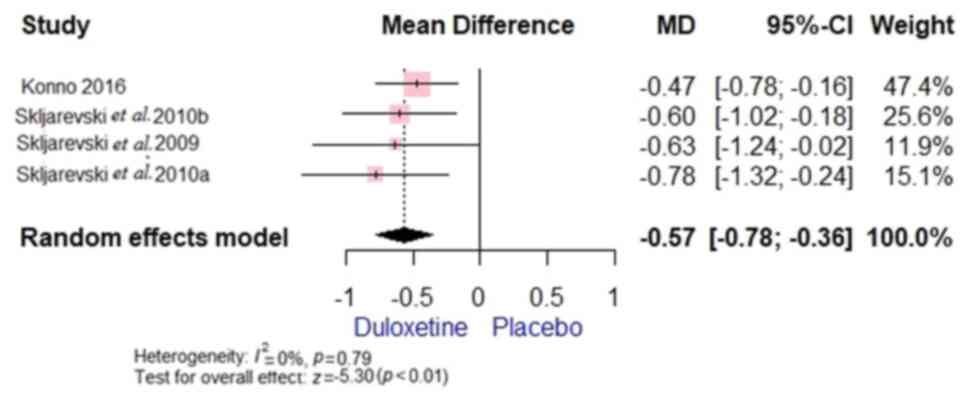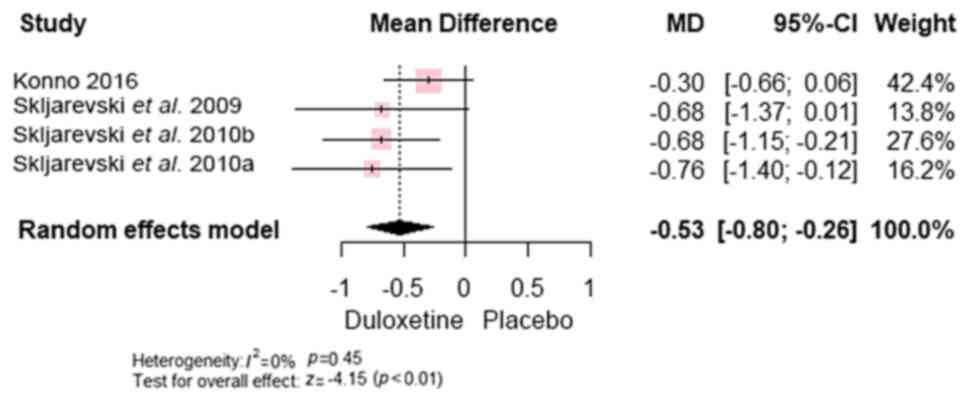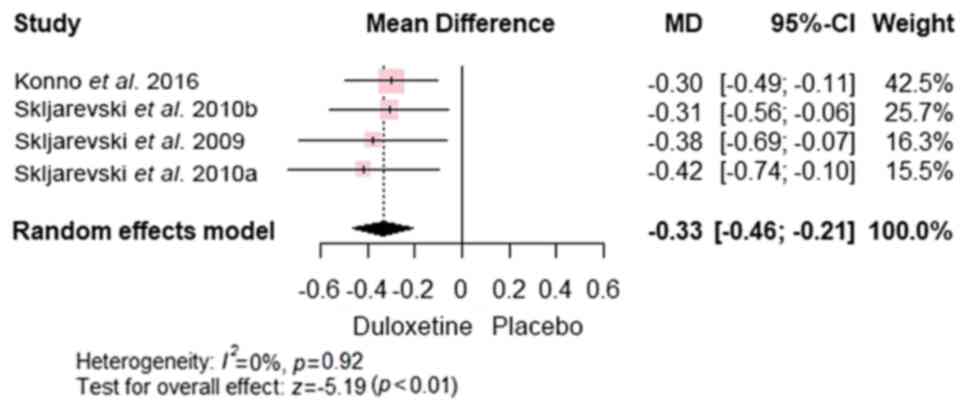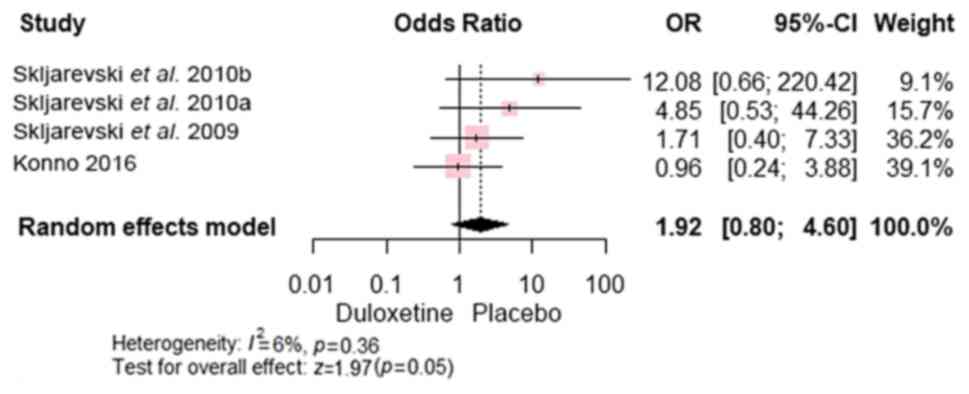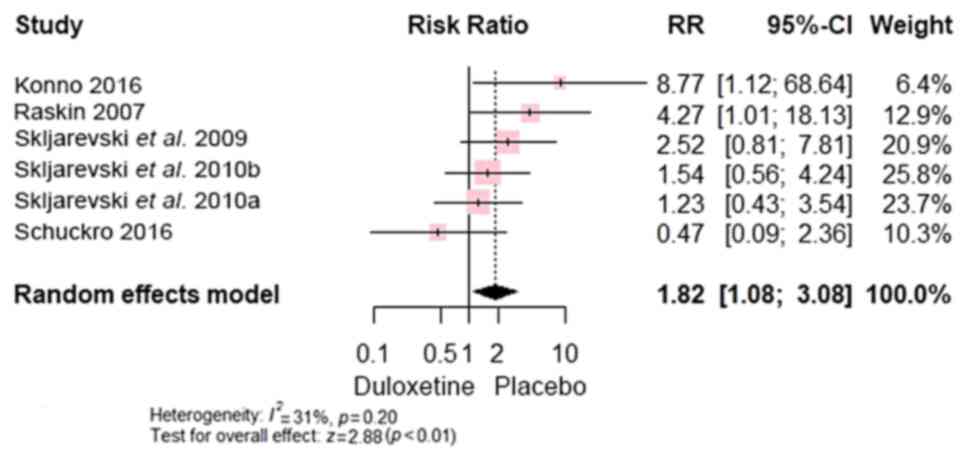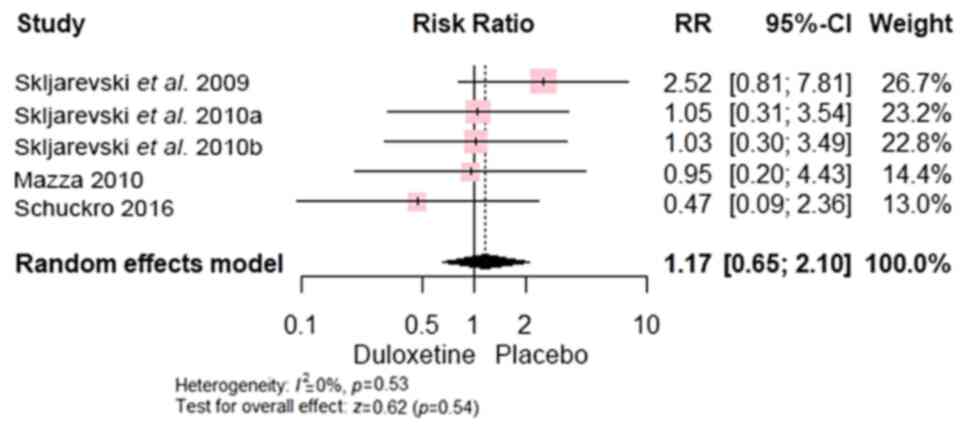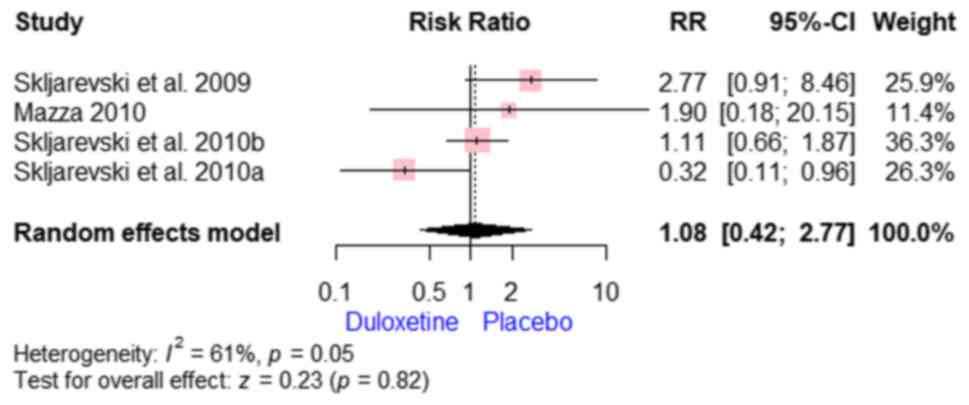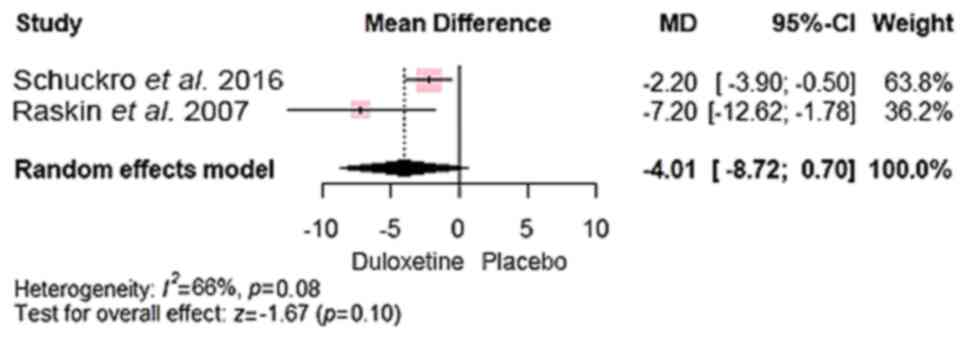Duloxetine for individuals with chronic back pain: A systematic review and meta‑analysis of randomized controlled trials
- Authors:
- Published online on: October 3, 2024 https://doi.org/10.3892/etm.2024.12738
- Article Number: 448
-
Copyright: © Bafail et al. This is an open access article distributed under the terms of Creative Commons Attribution License.
Abstract
Introduction
Chronic low back pain (CLBP) is a widespread public and occupational health issue, affecting ~23% of the population, with 11-12% experiencing disability (1,2). CLBP lasts 12 weeks or more and is influenced by various factors, including genetics, age, fitness level, weight and mental well-being (3,4). A number of studies have shown that the prevalence of CLBP steadily increases from the 3rd to the 6th decade of life, with a higher prevalence observed among women (3,4). In developed countries, 49-90% of individuals will experience at least one episode of low back pain in their lifetime, with the majority experiencing temporary relief within 2 weeks. However, 2-7% of people will go on to develop CLBP (3,4).
Duloxetine, a serotonin-noradrenaline reuptake inhibitor, increases dopamine levels in the prefrontal cortex and enhances the activity of noradrenergic and serotonergic neurons in the descending spinal pathway; thus, alleviates neuropathic and chronic pain (5,6). Clinical trials as well as systematic reviews, have demonstrated its effectiveness in treating CLBP, with significant improvements compared with placebo. A clinical trial conducted by Skljarevski et al (7), involving 404 patients with non-radicular CLBP over a 13-week period, demonstrated that the duloxetine group exhibited improvement in functional outcomes compared with the placebo group. Two previous systematic reviews by Weng et al (8) and Hirase et al (9) have been conducted to investigate the effect of duloxetine on CLBP. However, Weng et al (8) examined the impact of duloxetine on CLBP and osteoarthritis, while Hirase et al (9) performed a systematic review without a meta-analysis due to heterogeneity.
Considering the lack of comprehensive investigations into CLBP and the publication of recent clinical trials evaluating the use of duloxetine, the present systematic review was conducted to incorporate the most up-to-date evidence available as of the publication date of the present study. The current review aimed to not only assess the efficacy of duloxetine in managing CLBP but also explore its impact on the quality of life of the patients and the frequency of serious adverse effects.
Materials and methods
The present systematic review and meta-analysis adhered to the guidelines outlined in the Preferred Reporting Items for Systematic Reviews and Meta-Analyses (PRISMA) statement (10), ensuring methodological rigor and transparency throughout the research process.
Eligibility criteria
Randomized controlled trials (RCTs) that examined duloxetine across various dosage regimens in individuals suffering from chronic low back pain (CLBP) were included, compared with placebo. Observational studies, those with duplicated or overlapping populations, and those focusing solely on acute low back pain were excluded. Furthermore, studies that used accompanied treatment, such as exercise, electrotherapy or physiotherapy were excluded from this meta-analysis to maintain the integrity and relevance of the selected literature.
Search strategy
A comprehensive and systematic search strategy was developed based on four prominent electronic bibliographic databases: PubMed (https://pubmed.ncbi.nlm.nih.gov/), Web of Science (https://0710oser8-1106-y-https-www-webofscience-com.mplbci.ekb.eg/wos/woscc/basic-search), Cochrane Central (https://www.cochranelibrary.com/advanced-search) and Scopus (https://07105seqa-1106-y-https-www-scopus-com.mplbci.ekb.eg/search/form.uri?display=basic#basic). The present study aimed to maximize the retrieval of relevant articles published from the inception of each database up to March 2024. The search strategy used was as follows: For PubMed, (duloxetine hydrochloride OR duloxetine OR Cymbalta) AND (low back pain OR back pain OR back pain OR backache); for Web of Science, (duloxetine OR Cymbalta) AND (low back pain OR back pain OR back pain OR backache); for Cochrane, (duloxetine OR Cymbalta) AND (low back pain OR back pain OR back pain OR backache); and for Scopus, (duloxetine OR Cymbalta) AND (low back pain OR back pain OR back pain OR backache).
Study selection
A total of 2 independent reviewers performed the study selection process. Initially, titles and abstracts were screened to identify potentially eligible studies, followed by full-text screening to confirm eligibility based on the predefined inclusion and exclusion criteria.
Data extraction
Data extraction was conducted using a structured electronic data extraction sheet. A total of 2 independent reviewers extracted the following data from the included studies: Study name, year of publication, study design, interventions, duration of duloxetine treatment, sample size, mean age, male percentage, weight, follow up duration and outcome measures.
Definition of outcomes parameters
The visual analogue scale (VAS) is a subjective, self-reported, pain rating scale. It is used to track pain regression. A handwritten mark placed at one point along the length of a 10 cm line that represents a continuum between the two ends of the scale; ‘no pain’ on the left end (0 cm) of the scale and ‘worst pain’ on the right (10 cm). Measurements from the zero point (left end) of the scale to the patients' marks are recorded in cm and are interpreted as their pain (11).
The Brief Pain Inventory (BPI) is a self-reported assessment. It provides information on the intensity of pain (sensory dimension or BPI-severity) and the degree to which pain interferes with function (reactive dimension or BPI-Interference). BPI-I is rated on a scale of 0 (no interference) to 10 (interferes completely). The average of 7 items or questions that the BPI-I scale addresses (general activity, mood, walking ability, normal work, relations with other people, sleep and enjoyment of life) were reported (12). The Roland-Morris Disability Questionnaire-24 (RMDQ-24) measures physical disability due to CLBP on a scale ranging from 0 (no disability) to 24 (severe disability) (13).
The SF-36 includes 36 questions. In total, 8 different sub-scores (physical and social functioning, physical and emotional role limitations, mental health, energy, pain, and general health perceptions), and a mental and physical summary score can be obtained from these. A maximum score of 100 resembles the best possible health state (14). Patients' global impression of improvement (PGI-I) compares a participant's perception of improvement at the time of assessment with treatment initiation time. Score varies from 1 (very much better) to 7 (very much worse) (15).
Of the included studies, only Raskin et al (16) specifically addressed depression, defining it according to DSM-IV criteria (17). While this definition was referenced in the present study, none of the other 7 studies included a focus on depression. Depression was defined according to the criteria of DSM- IV (17). The included study by Raskin et al (16) also defined depression as in the DSM-IV. The diagnosis was confirmed by the Mini International Neuropsychiatric Interview, a standardized diagnostic interview based on DSM-IV criteria (17). Baseline disease severity was defined by patients' scores on the Hamilton Depression Rating Scale with 17 items (HAM-D) (18). Patients were required to have a HAM-D total score of ≥18 at visits 1 and 2; a Mini-Mental State Examination (MMSE) score of ≥20 with or without mild dementia; and at least one previous episode of major depression. Patients with an MMSE score of 20 to 23 were categorized as having mild dementia, while those with a score of ≥24 were categorized as having no dementia (18).
Quality assessment
The risk of bias in the included RCTs was assessed using the well-established Cochrane collaboration tool (19). This evaluation included sequence generation, allocation concealment, blinding, incomplete outcome data, selective outcome reporting and other potential sources of bias. Each study's bias risk was categorized as ‘Low’, ‘High’, or ‘Unclear’ ensuring a comprehensive understanding of the methodological quality and robustness of the included studies.
Data analysis
For dichotomous data, risk ratios (RR) with 95% confidence intervals (CIs) were used. For continuous data, the mean differences (MD) with 95% CI were employed. Data synthesis was performed using the R software (meta-package; v.6.5-0; https://www.r-project.org/). Visual inspection of the forest plots and measurement of the Q and I2 statistics were used to assess heterogeneity. Significant statistical heterogeneity was indicated by the Q statistic P<0.1 or I2>50%. Random effect model was used in the meta-analysis.
Results
Search results
A total of 740 records were identified, 235 redundant entries were removed and 505 unique records were reviewed. After assessing the full-text articles, the pool was narrowed down to 24 relevant studies, and finally a total of 8 studies were included in the meta-analysis. Any discrepancies were resolved through discussion and consensus to ensure the robustness and integrity of the study selection process. The study selection process is shown in Fig. 1.
Study characteristics
The included studies collectively enrolled a total of 1,985 patients. These studies have exhibited diverse characteristics, as summarized in Table I. The methodological quality of each study was evaluated using the Cochrane collaboration tool, illuminating a spectrum ranging from moderate to high quality (Fig. 2).
Outcomes. Pain reduction and physical improvement
The results revealed that duloxetine was superior to placebo in reducing pain intensity, as demonstrated by significant improvements on both the VAS (20,21) [MD, -2.82; 95% CI, (-3.67 to -1.97); P<0.0001]. A subgroup analysis was conducted to differentiate patients with concomitant depression from those with only CLBP. The results of both groups (CLBP with and without depression) showed that duloxetine had significant advantage over control [MD, -2.71; 95% CI, (-3.57 to -1.85) and MD, -7.20; 95% CI, (-12.62 to -1.78), respectively] (Fig. 3).
Furthermore, the overall mean difference favoured duloxetine over control in terms of the BPI score (7,22-24) [MD, -0.78; 95% CI, (-1.42 to -0.13); P<0.0001] (Fig. 4). In addition, the overall mean difference between favoured duloxetine over control regarding the RMDQ-24 scale [MD, -0.87; 95% CI, (-1.36 to -0.39), P<0.0001] (Fig. 5), BPI-S average pain [MD, -0.57; 95% CI, (-0.78 to -0.36); P<0.00001] (Fig. 6) and worst pain [MD, -0.53; 95% CI, (-0.80 to -0.26); P<0.0001] (Fig. 7).
Quality of life. One study (21) reported on impact of duloxetine on overall SF-36 scores, and showed no significant difference between the compared groups [MD, 4.30; 95% CI, (-3.59 to 12.19); P>0.05].
PGI-I. Assessment of PGI-I across the 4 studies (7,22-24) revealed significant advantages of duloxetine over placebo [MD, -0.33; 95% CI, (-0.46 to -0.21); P<0.0001)], with no significant heterogeneity (P=0.92 and I2=0%) (Fig. 8).
Safety and tolerability. In total, 7 studies reported data on safety and tolerability while the study conducted by Samadi et al (21) did not report any data on side effects. The analysis revealed no significant difference in the occurrence of serious adverse events (chest pain, vertigo, dyspnoea, perioral numbness, perioral numbness, myocardial infarction, toxic myopathy, asthma and alcohol poisoning) between the duloxetine and control groups [RR, 1.92; 95% CI, (0.80 to 4.60); P=0.054], with studies (7,22-24) demonstrating homogeneity (P=0.36 and I2=6%) (Fig. 9).
Compared with control, duloxetine exhibited more constipation [RR, 3.00; 95% CI, (1.86 to 4.84); P<0.00001] (Fig. 10), diarrhoea [RR, 1.82; 95% CI, (1.08 to 3.08); P<0.0001] (Fig. 11), nausea [RR, 4.37; 95% CI, (2.86 to 6.67); P<0.00001] (Fig. 12) and dizziness [RR, 2.94; 95% CI, (1.70 to 5.09); P=0.0001] (Fig. 13). In addition, no significant difference was found between both groups regarding insomnia [RR, 1.17; 95% CI, (0.65 to 2.10); P=0.54] (Fig. 14) and headache [RR, 1.08; 95% CI, (0.42 to 2.77); P=0.82] (Fig. 15).
Sensitivity analysis. A sensitivity analysis was performed to evaluate the impact of excluding the study by Samadi et al (21) that included post-surgical patients. The aforementioned study only reported on the VAS outcome. After removing it, the analysis did not show significant difference between duloxetine and placebo in terms of VAS outcome, as revealed in Fig. 16.
Discussion
The present study, including eight RCTs, provides robust evidence, supporting the efficacy of duloxetine in reducing pain and enhancing quality of life of patients with CLBP. Duloxetine demonstrated superior outcomes over placebo in pain reduction measured by the VAS, BPI, BPI-S, RMDQ-24 scales and worse pain scales. In addition, duloxetine improved quality of life assessed by the SF-36. Clinically, these results favor the duloxetine group, indicating its efficacy in alleviating CLBP symptoms and enhancing patients' overall well-being (25,26).
Although the overall trend supports the effectiveness of duloxetine, individual study outcomes may vary. Variations in the study design, patient populations and methodological approaches contributed to the observed heterogeneity. Discrepancies in the findings can be attributed to factors such as differences in drug dosage, concomitant medication usage, and patient characteristics such as age and comorbidities. Methodological disparities, including study duration and outcome measures, also contribute to variability among studies (27).
The superiority of the duloxetine group over the placebo is scientifically grounded in its pharmacological mechanism of action. As an antidepressant and serotonin-noradrenaline reuptake inhibitor, duloxetine modulates neurotransmitter levels in the central nervous system and attenuates pain-signaling pathways. This neurobiological mechanism, coupled with the demonstrated efficacy in clinical trials, elucidates why the duloxetine group exhibited superior outcomes in terms of pain reduction and quality of life improvement (28,29).
Previous studies have similarly highlighted the efficacy of duloxetine in the management of CLBP, corroborating the present findings (30,31). However, the present study advances the existing literature by incorporating the most up-to-date evidence through a comprehensive systematic review and meta-analysis. These findings align with those of previous studies that underscore the effectiveness of duloxetine in treating CLBP (9). Nevertheless, the present study provides additional insights and robust evidence, further strengthening the existing body of literature on this topic.
The strengths of the present study include a comprehensive methodology adhering to the PRISMA guidelines, meticulous selection and analysis of relevant studies, and robust assessment of study quality. However, limitations include the observed heterogeneity across studies, potential biases inherent in meta-analyses and limited number of included studies, which may affect the generalizability of the findings.
Based on these results, future research should focus on specific subpopulations, such as patients with depression and CLBP, and explore the comparative efficacy of duloxetine in conjunction with conservative therapies. Additionally, further investigations into the efficacy of duloxetine across various types of back pain and its long-term effects are warranted. Future studies should also address the methodological inconsistencies and biases observed in previous research to strengthen the evidence base for the use of duloxetine in managing CLBP.
In conclusion, the present study has yielded promising outcomes concerning pain alleviation and improvements in the quality of life among individuals afflicted with CLBP. While acknowledging limitations such as study heterogeneity and the restricted number of included studies, the findings present compelling evidence for the efficacy of duloxetine in mitigating CLBP. These results highlight the potential of duloxetine as a valuable therapeutic intervention in CLBP management, particularly in individuals with comorbid depression. Further research is imperative to address the prevailing limitations and comprehensively validate these findings. Such efforts are crucial for refining treatment approaches and advancing CLBP management on a global scale.
Acknowledgements
Not applicable.
Funding
Funding: No funding was received.
Availability of data and materials
The data generated in the present study may be requested from the corresponding author.
Authors' contributions
MSAS, AZA and DB conceptualized and designed the study, contributed to data analysis and interpretation, and played a major role in writing the manuscript. HEM and ZB did the initial screening while ZB and DB contributed to full text screening and data interpretation. HEM and ZB curated and analyzed the data, created visualizations, and contributed to the interpretation of results. DB, HEM and ZB drafted the initial manuscript, synthesized study findings, and incorporated feedback from co-authors. All authors read and approved the final version of the manuscript. MSAS and HEM confirm the authenticity of all the raw data.
Ethics approval and consent to participate
Not applicable.
Patient consent for publication
Not applicable.
Competing interests
The authors declare that they have no competing interests.
References
|
Alfalogy E, Mahfouz S, Elmedany S, Hariri N and Fallatah S: Chronic low back pain: Prevalence, impact on quality of life, and predictors of future disability. Cureus. 15(e45760)2023.PubMed/NCBI View Article : Google Scholar | |
|
Kahere M, Hlongwa M and Ginindza TG: A scoping review on the epidemiology of chronic low back pain among adults in sub-saharan africa. Int J Environ Res Public Health. 19(2964)2022.PubMed/NCBI View Article : Google Scholar | |
|
Nicol V, Verdaguer C, Daste C, Bisseriex H, Lapeyre É, Lefèvre-Colau MM, Rannou F, Rören A, Facione J and Nguyen C: Chronic low back pain: A narrative review of recent international guidelines for diagnosis and conservative treatment. J Clin Med. 12(1685)2023.PubMed/NCBI View Article : Google Scholar | |
|
Hnatešen D, Pavić R, Radoš I, Dimitrijević I, Budrovac D, Čebohin M and Gusar I: Quality of life and mental distress in patients with chronic low back pain: A cross-sectional study. Int J Environ Res Public Health. 19(10657)2022.PubMed/NCBI View Article : Google Scholar | |
|
Onuţu AH: Duloxetine, an antidepressant with analgesic properties-A preliminary analysis. Rom J Anaesth Intensive Care. 22:123–128. 2015.PubMed/NCBI | |
|
Dhaliwal JS, Spurling BC and Molla M: Duloxetine. StatPearls. Treasure Island (FL): StatPearls Publishing Copyright ©. 2024, StatPearls Publishing LLC.; 2024. | |
|
Skljarevski V, Zhang S, Desaiah D, Alaka KJ, Palacios S, Miazgowski T and Patrick K: Duloxetine versus placebo in patients with chronic low back pain: A 12-week, fixed-dose, randomized, double-blind trial. J Pain. 11:1282–1290. 2010.PubMed/NCBI View Article : Google Scholar | |
|
Weng C, Xu J, Wang Q, Lu W and Liu Z: Efficacy and safety of duloxetine in osteoarthritis or chronic low back pain: A systematic review and meta-analysis. Osteoarthritis Cartilage. 28:721–734. 2020.PubMed/NCBI View Article : Google Scholar | |
|
Hirase T, Hirase J, Ling J, Kuo PH, Hernandez GA, Giwa K and Marco R: Duloxetine for the treatment of chronic low back pain: A systematic review of randomized placebo-controlled trials. Cureus. 13(e15169)2021.PubMed/NCBI View Article : Google Scholar | |
|
Page MJ, McKenzie JE, Bossuyt PM, Boutron I, Hoffmann TC, Mulrow CD, Shamseer L, Tetzlaff JM, Akl EA, Brennan SE, et al: The PRISMA 2020 statement: An updated guideline for reporting systematic reviews. BMJ. 372(n71)2021.PubMed/NCBI View Article : Google Scholar | |
|
Gift AG: Visual analogue scales: Measurement of subjective phenomena. Nur Res. 38:286–288. 1989.PubMed/NCBI | |
|
Cleeland CS and Ryan KM: Pain assessment: Global use of the brief pain inventory. Ann Acad Med Singap. 23:129–138. 1994.PubMed/NCBI | |
|
Stratford PW and Riddle DL: A roland morris disability questionnaire target value to distinguish between functional and dysfunctional states in people with low back pain. Physiother Can. 68:29–35. 2016.PubMed/NCBI View Article : Google Scholar | |
|
Hays RD, Sherbourne CD and Mazel RM: The rand 36-item health survey 1.0. Health Econ. 2:217–227. 1993.PubMed/NCBI View Article : Google Scholar | |
|
Srikrishna S, Robinson D and Cardozo L: Validation of the patient global impression of improvement (PGI-I) for urogenital prolapse. Int Urogynecol J. 21:523–528. 2010.PubMed/NCBI View Article : Google Scholar | |
|
Raskin J, Wiltse CG, Siegal A, Sheikh J, Xu J, Dinkel JJ, Rotz BT and Mohs RC: Efficacy of duloxetine on cognition, depression, and pain in elderly patients with major depressive disorder: An 8-week, double-blind, placebo-controlled trial. Am J Psychiatry. 164:900–909. 2007.PubMed/NCBI View Article : Google Scholar | |
|
Stein DJ, Phillips KA, Bolton D, Fulford KW, Sadler JZ and Kendler KS: What is a mental/psychiatric disorder? From DSM-IV to DSM-V. Psychol Med. 40:1759–1765. 2010.PubMed/NCBI View Article : Google Scholar | |
|
Nixon N, Guo B, Garland A, Kaylor-Hughes C, Nixon E and Morriss R: The bi-factor structure of the 17-item hamilton depression rating scale in persistent major depression; dimensional measurement of outcome. PLoS One. 15(e0241370)2020.PubMed/NCBI View Article : Google Scholar | |
|
Higgins JPT, Altman DG, Gøtzsche PC, Jüni P, Moher D, Oxman AD, Savovic J, Schulz KF, Weeks L and Sterne JAC: Cochrane Bias Methods Group; Cochrane Statistical Methods Group. The Cochrane collaboration's tool for assessing risk of bias in randomised trials. BMJ. 343(d5928)2011.PubMed/NCBI View Article : Google Scholar | |
|
Schukro RP, Oehmke MJ, Geroldinger A, Heinze G, Kress HG and Pramhas S: Efficacy of duloxetine in chronic low back pain with a neuropathic component: A randomized, double-blind, placebo-controlled crossover trial. Anesthesiology. 124:150–158. 2016.PubMed/NCBI View Article : Google Scholar | |
|
Samadi A, Salehian R, Kiani D and Jolfaei AG: Effectiveness of duloxetine on severity of pain and quality of life in chronic low back pain in patients who had posterior spinal fixation. J Orth Trauma Rehabil. 6(144)2021. | |
|
Konno S, Oda N, Ochiai T and Alev L: Randomized, double-blind, placebo-controlled phase III trial of duloxetine monotherapy in Japanese patients with chronic low back pain. Spine (Phila Pa 1976). 41:1709–1717. 2016.PubMed/NCBI View Article : Google Scholar | |
|
Skljarevski V, Desaiah D, Liu-Seifert H, Zhang Q, Chappell AS, Detke MJ, Iyengar S, Atkinson JH and Backonja M: Efficacy and safety of duloxetine in patients with chronic low back pain. Spine (Phila Pa 1976). 35:E578–E585. 2010.PubMed/NCBI View Article : Google Scholar | |
|
Skljarevski V, Ossanna M, Liu-Seifert H, Zhang Q, Chappell A, Iyengar S, Detke M and Backonja M: A double-blind, randomized trial of duloxetine versus placebo in the management of chronic low back pain. Eur J Neurol. 16:1041–1048. 2009.PubMed/NCBI View Article : Google Scholar | |
|
Brown JP and Boulay LJ: Clinical experience with duloxetine in the management of chronic musculoskeletal pain. A focus on osteoarthritis of the knee. Ther Adv Musculoskelet Dis. 5:291–304. 2013.PubMed/NCBI View Article : Google Scholar | |
|
Rodrigues-Amorim D, Olivares JM, Spuch C and Rivera-Baltanás T: A systematic review of efficacy, safety, and tolerability of duloxetine. Front Psychiatry. 11(554899)2020.PubMed/NCBI View Article : Google Scholar | |
|
Jia Z, Yu J, Zhao C, Ren H and Luo F: Outcomes and predictors of response of duloxetine for the treatment of persistent idiopathic dentoalveolar pain: A retrospective multicenter observational study. J Pain Res. 15:3031–3041. 2022.PubMed/NCBI View Article : Google Scholar | |
|
Yasuda H, Hotta N, Nakao K, Kasuga M, Kashiwagi A and Kawamori R: Superiority of duloxetine to placebo in improving diabetic neuropathic pain: Results of a randomized controlled trial in Japan. J Diabetes Investig. 2:132–139. 2011.PubMed/NCBI View Article : Google Scholar | |
|
Obata H: Analgesic mechanisms of antidepressants for neuropathic pain. Int J Mol Sci. 18(2483)2017.PubMed/NCBI View Article : Google Scholar | |
|
Onda A and Kimura M: Reduction in anxiety during treatment with exercise and duloxetine is related to improvement of low back pain-related disability in patients with non-specific chronic low back pain. Fukushima J Med Sci. 66:148–155. 2020.PubMed/NCBI View Article : Google Scholar | |
|
Ferreira GE, McLachlan AJ, Lin C-WC, Zadro JR, Abdel-Shaheed C, O'Keeffe M and Maher CG: Efficacy and safety of antidepressants for the treatment of back pain and osteoarthritis: Systematic review and meta-analysis. BMJ. 372(m4825)2021.PubMed/NCBI View Article : Google Scholar | |
|
Mazza M, Mazza O, Pazzaglia C, Padua L and Mazza S: Escitalopram 20 mg versus duloxetine 60 mg for the treatment of chronic low back pain. Expert Opin Pharmacother. 11:1049–1052. 2010.PubMed/NCBI View Article : Google Scholar |



